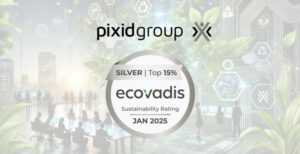Business intelligence in the temporary staffing sector: how to analyze data to optimize the use of temporary workers?
We live in a world of data that needs to be tamed. Business intelligence helps all sectors of activity to master and exploit Big Data, including HR. In the temporary staffing sector, data analysis is often used to optimize costs. However, business intelligence tools can also make a significant contribution to improving processes.
Between Workforce 2.0 and traditional agencies, the point of balance is undoubtedly in phygital temping, a blend of the best digital techniques while retaining the indispensable human relationship.

Business intelligence and big data
Business intelligence has entered the professional vocabulary at the same time as big data. The latter refers to today’s ability to manage vast quantities of data. Big data is measured in terabytes, or 1,000 billion bytes. Faced with such volumes, business intelligence has come to the rescue of our outmoded brains, enabling us to sort, read, interpret and act on the vast amounts of data collected.
Business intelligence takes the form of data analysis tools that can be used to manage and measure the effectiveness of an action, in any field: customer relations, new product launches, recruitment campaigns.
The data analysis process involves several stages:
- collect and sort the right data,
- analyze and interpret what emerges from the data,
- set up and monitor key performance indicators (KPIs),
- optimize processes based on these KPIs.
Data analysis is only useful if it is followed by action, which in turn is measured, to enter into a virtuous spiral of continuous improvement.
Data analysis for the contingent workforce
Applied to the temporary staffing industry, business intelligence offers numerous possibilities: cost reduction, time savings, identification of areas for improvement.
Reducing temporary employment costs
Setting up the right indicators makes it easy to calculate every cost, whether incurred by your own departments or invoiced by an external service provider. For example, for a temporary vacancy, how many agencies were contacted? How much time was spent by HR in drawing up the assignment details, and in discussions with the staffing firm? Another example: to determine the return on investment (ROI) of a contingent workforce management software program, you need to identify precisely, and with figures to back it up, the stages at which its action is decisive.
Faster, more accurate contingent workforce management
Data analysis enables us to pinpoint every stage in the temping process – and we know how complex it can be. The next step is to retrieve the relevant data, from the publication of the assignment to its completion. This enables you to calculate your applicant conversion rate: how many applications you receive for each temp recruited.
But we can go even further: how much time does HR spend on a temporary assignment lasting a few days? How can this time be reduced, thanks in particular to digital solutions? How can we optimize our knowledge of a temporary worker, for example by exploiting a pool in which the best workers can easily update their availability?
Data and KPIs must also reveal what’s not working: a low response rate to an advert may mean that it’s not being published on the right site. By identifying the friction points at each stage, we can develop optimization paths and draw up an action plan.
What are the KPIs in the temporary staffing business ?
Finally, in a world of massive data, the hardest part can be finding the relevant data to define the right KPIs. In the contingent staffing industry, as elsewhere, there are quantitative KPIs, qualitative KPIs and optimization KPIs.
Quantitative KPIs
In quantitative terms, temporary work can be measured in several ways:
- in time: – duration of temporary assignments, response time to requests for interviews or information,
- in money: invoicing data (number, amount, evolution),
- in numbers: number of applications received, number of temporary assignments per year, and any seasonal fluctuations in the use of temporary staff.
Qualitative KPIs
Here, we are more interested in the number of unfilled requests, the reasons for using a temporary worker, the time spent on a single assignment (from its definition to its evaluation at the end of the assignment), the evaluation of the quality of sources or that of the candidate experience and the onboarding of the temporary worker. This fine-tuned approach will enable us to build action plans on the customer’s side, but also with our service providers, to better manage specific risks and difficulties (regulatory, HR, financial, operational, etc.).
KPIs for optimizing supplier relations in the temping industry
Certain KPIs are particularly useful for measuring optimization actions with service providers. For example, tracking the number of applications per agency by site and qualification, along with proposed rates, provides essential insights for negotiating a framework agreement.
Conclusion
When contingent staffing expenditure exceeds three million dollars a year, it’s essential to implement a tool that automatically identifies any discrepancies and saves, on average, between 0.5% and 1.5% of annual expenditure.
Business intelligence not only enables cost optimization but also improves processes and decision-making, ensuring that the temporary employment sector becomes more efficient and responsive to evolving demands.
Where is this – sounds very small number? Globally spend on temporary staff (through platforms) was $21bn in 2022
It’s not a key market figure, but what we’re saying is that if a company is worth more than €3 million, it can be very important for them to digitise and use a platform like Pixid.





